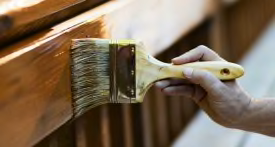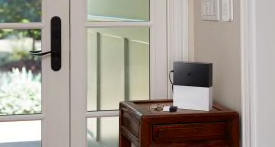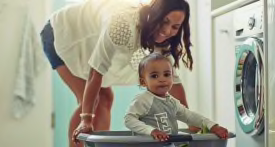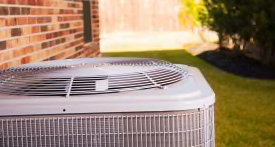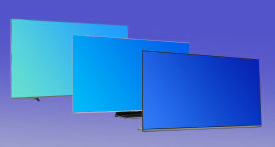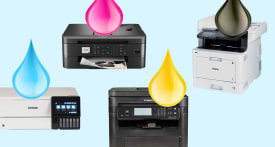A garden hose, soap, and elbow grease can take care of many a cleanup job—if you want to spend all day on it. But if you have better things to do, a pressure washer speeds up all sorts of onerous tasks, from scrubbing grime and mildew from siding and getting oil stains off a driveway to cleaning a deck or patio, sprucing up outdoor furniture, degreasing a grill, and even washing a car.
Pressure washers use either a gas engine or an electric motor, a pump, and a concentrating nozzle to boost water pressure from your hose connection by 30 to 80 times. Though a garden hose alone delivers water pressure at about 50 pounds per square inch, pressure washers can generate 1,500 to 4,000 psi. That's a lot of power. And when operated properly, they blast away stains without damaging the surface material beneath.
But despite the benefits, they can cause serious injury—and few consumers may appreciate just how serious. A pressure washer's powerful spray is hazardous when misdirected, strong enough to damage skin in an instant. Lacerations are the most common injury, followed by bruises, punctures, and eye injuries.
Lee Krause of Alberta, Canada, was using his gas-powered pressure washer to clean his ATV when the spray passed over his hand for an instant. He didn't go to a hospital, but six years later there's a scar to remind him to keep his guard up. He was one of the lucky ones.
"The extreme danger with pressure washers is that even with what seems a very minimal skin break, the fluid can get deep into the tissue and spread out and cause bacterial infection," says Howard Mell, M.D., a spokesman for the American College of Emergency Physicians. He recalls a patient who was hit in the calf, producing a laceration less than 2 inches across. But internally, there was infection to the muscle. It took a long operation and months of physical therapy for the patient to heal.
Pressure washers are sold with either a set of interchangeable nozzles or an adjustable wand tip, both of which usually allow users to vary the flow of water from zero degrees, the finest, to about 65 degrees depending on the task. (See our guide to nozzles and settings, below.) They're inherently dangerous no matter which spray tip or setting you're using. But the unnecessary risk of using a zero-degree nozzle—which concentrates the tool's full pressure into a single, pinpoint blast—outweighs the utility because the spray can cause severe damage in a short amount of time. And higher-degree nozzles can get the job done.
Rental World in Lancaster, Pa., won't include zero-degree nozzles when it rents pressure washers. "We warn customers that they're dangerous even with wider-degree nozzles," explains Vern Dettinger, the store's manager.
The Pressure Washer Manufacturers' Association notes that a pressure washer's manual and markings on the products themselves describe safe use, and it stands by the utility of zero-degree nozzles.
"The zero-degree nozzle in this case may be used to extend the reach of the water and thus eliminate the need of a ladder," the trade group said in a statement. "In addition, it may also be used for etching or removing extremely stubborn debris prior to washing or rinsing using 15-degree or larger-angle nozzles."
Our Recommendation
An estimated 6,057 people in 2014 alone went to an emergency room with injuries related to pressure washer use, according to the Consumer Product Safety Commission. And 14 percent of those ER visits led to additional hospitalization. (Not all of the injuries could be attributed to contact with a powerful spray.)
The same kind of cleaning can be done with wider-angle settings; it just might take a bit longer. And many pressure washers let you connect wand extensions to reach higher surfaces without resorting to a zero-degree nozzle.
Based on the potential extreme risk of very narrow nozzles and their limited benefit, we no longer recommend pressure washers that come with nozzles that produce sprays of less than 15 degrees, despite how well they clean.
We have confined our pressure washer recommendations to two products that scored sufficiently well and lack the capability, as sold, to create a zero-degree stream. They are the GreenWorks GPW1951, $190 (a 1,950 psi 120-volt electric-powered washer), and the NorthStar 1573021, $850 (a 3,000 psi 240-volt electric). We tested the NorthStar to see whether you can get the performance of a gas machine with an electric model. You can, but only if you're willing to pay a premium for the tool and for installing a 240-volt line for it. So it's likely to be of niche appeal.
If you buy a model that comes with a zero-degree nozzle (it's red) or you already own one, we advise that you get rid of it to reduce the chance of damaging property or causing injury to you, your family members, or anyone else who might use the sprayer. And if your power washer comes with a zero-degree adjustable setting, we recommend that you not use it.
In addition, wear goggles, long pants, and sturdy footwear—never flip-flops—to protect yourself while using any pressure washer.
To ensure pressure washer safety, we're asking manufacturers to stop including tips and settings that produce streams finer than 15 degrees. We have also notified the CPSC of our findings and our advice for consumers. If products that meet our performance criteria are updated to comply with our pressure washer safety expectations, we will add them to our list of picks.
Color Coded
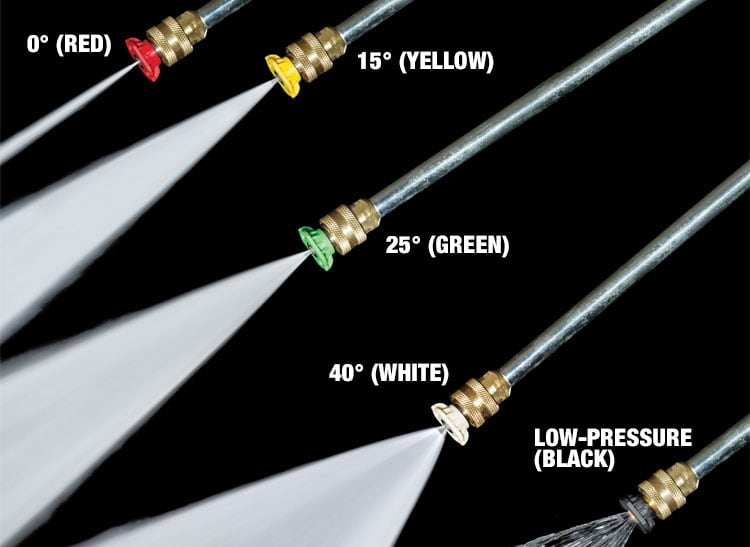
0˚ (red)
For removing tough stains and dirt from concrete, cleaning in crevices, and washing second-story siding. But at closer distances, it can cause serious injury. We don't recommend its use because higher-degree nozzles can get the job done without the unnecessary risk.
15˚ (yellow)
For heavy-duty cleaning of concrete, such as outdoor walks and garage floors, plus stripping paint and grease from hard surfaces.
25˚ (green)
For general cleaning of outdoor furniture, patios, walks, and decks.
40˚ (white)
For more easily damaged surfaces, such as siding and stucco walls, and for cleaning vehicles.
Low-pressure (black)
For cleaning agents only. Attaching this tip reduces pressure, which triggers the pressure washer to draw from the soap dispenser as well as the water supply.
Before You Buy a Pressure Washer
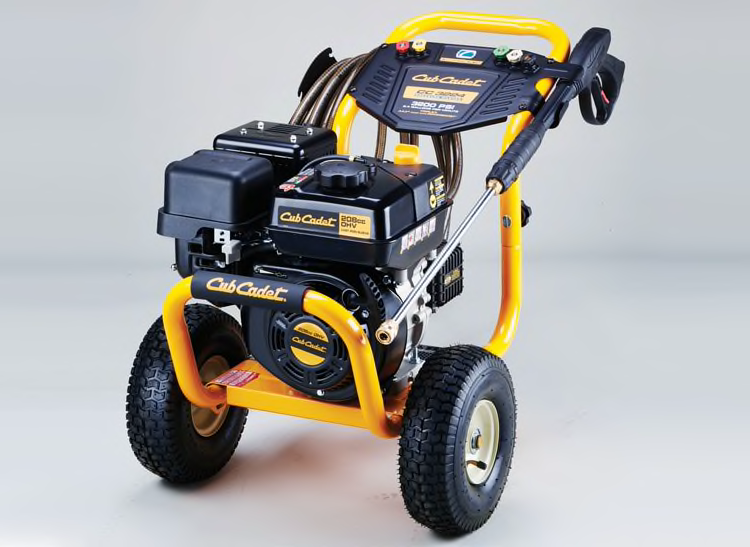
Pressure washers are easy to rent. You can get a gas-powered unit for about $75 to $100 for a day. But owning one—and being able to use it whenever you want—has become irresistible for many homeowners. (In fact, sales of pressure washers have grown 15 to 20 percent in the past four years.) So if you're in the market, here's some guidance:
All models are sold with an indication of the machine's pressure capacity, expressed in pounds per square inch, or psi. The higher the psi, the more powerful the tool. Many of them will also indicate the gallons per minute (gpm) used. Though that's not a meaningful indication of power, it can show which sprayers can clean using less water.
Gas models, which range in price from $250 to $500, deliver more pressure, making them the pick for cleaning large decks, siding, driveways, and other large areas most quickly. But they're relatively noisy and heavy, and their engines require regular tuneups and proper off-season storage.
Corded-electric sprayers, which cost $100 to $250, aren't as powerful, so they might not be able to remove stubborn stains from concrete and will take more time to clean. But they're fine for cleaning small decks and patios, furniture, and cars. They're relatively light and quiet, require little upkeep, and are small enough to be stored indoors without winterizing.
Editor's Note: This article also appeared in the March 2016 issue of Consumer Reports magazine.
How to Clean Your Deck
Is your deck looking tired and dingy? On the "Consumer 101" TV show, Consumer Reports' test engineer Dave Trezza shows how to revive your outdoor space.






